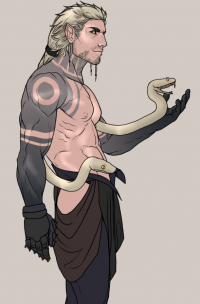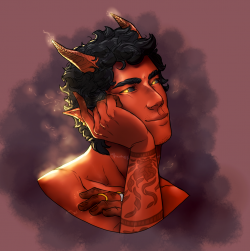Manathar
| Manathar | |
|---|---|
 | |
| Fauna | |
| Official Name | Manathar |
| Common Nicknames | Pridelings, Demons, Confused Maraya |
| Classification | Magus |
| Habitat | Various areas of Aloria |
| Current Status | Extinct |
The Manathar were an Affliction in Aloria which emerged from the desire of a group of Kathar to further their evolution as a Race. The Pride Arken fulfilled their desire, but within just three years, took away the Affliction from the world. The three Legions, or strains of the Affliction, created rather demonic-looking individuals from any group of Elven background, including Half-Elves, and capable of absorbing groups like Arkenborn into their ranks through the transformation. Ultimately, the footprint the Manathar left on Aloria is uncertain, as while some individuals used their power to aid in various expeditions and conflicts across Aloria, many more faded from memory, or left little lasting impact beyond their appearance.
History
The Manathar were originally Kathar of the Dread Empire who sought to change their condition, and turned to the Pride Arken for such an opportunity in 307 AC. The being agreed to their pact, and transformed them into the first Manathar, before then approaching different Void Worshipers across Aloria and offered them a similar transformation into this new Affliction. Many accepted, among them a high number of Arkenborn, and were thus transformed into the three Legions. Pride emparted them with guiding principles, based on the concepts of the original Dread Kathar Manathar, and also gave them the ability to turn other, willing supplicants of the Nelfin Races, before stepping back and allowing affairs to play out. Unfortunately for the Arken’s goals or designs, many Manathar failed to adhere to these principles. While The Mentor, as Pride became known among the Manathar, had created powerful and unique beings, many misused the gifts, or broke away from the Legions who had trouble even working together in many instances. Additionally, while their bodies had been changed, their minds had not been altered sufficiently by the experience, so original enmities and bias creeped into the Manathar. This eventually called The Mentor out, who set down new rules of internal faith and governance while also tweaking the powers present in each of the Legions. But, ultimately, this was not enough. In 310 AC, the Arken chose to finally cut the thread of Magic that gave the Manathar their powers, instantly reverting all of them back overnight to their prior state. While there was some initial confusion on why this happened, later searches for answers revealed that the Arken had been disappointed in their children. Many former Manathar are just grateful that the being simply disbanded the Affliction as a failure, rather than punish them for failure.
Physical Appearance
The Manathar had a broad range of visual differences based on their individual Legions, however all possessed the traits of horns, a tail, and golden irises with dark gray eyes or black eye-whites. Arkenborn Manathar were distinguished by a red limbal ring around their irises, being the only exception to the Affliction’s shared similarities. These changes never rendered them unrecognizable, but were also seen as permanent, with no possibility of altering one’s form or appearance further.
Diversity
As mentioned before, the diversity of the Manathar was broken into the three Legions, each having a role to play in the new society Pride sought to create with the Affliction.
- The Apostle Legion: The Apostles were the most archetypally demonic Manathar in appearance, possessing the most vibrant skin tones, ranging from warm metallic shades like bronze and copper, to hues of crimson and burnt orange. Apostle Legion horns were curled and ridged, with a broad formation set apart more than the horns of other Legions. Their tails varied in size, and had a gradient into a black spade-like tip, or a tuft of black fur. These Manathar were the warriors, fighters, and defenders of the other Legions.
- The Cardinal Legion: These Manathar were visually the least-affected Legion. Their skin tones ranged from those of the Teledden to those of the Suvial. Uniquely, the extremities of the Cardinals, such as their hands, were inky black, with each appendage gradienting back into their normal skin colors. Cardinal horns were typically straight, smooth, and delicate, with thin and delicate tails as well. Both were textured as if scaled. Uniquely, Cardinal Manathar possesses a pair of snakes that sprout from their lower scalp. These snakes were sentient, but could not cause harm, and could be painlessly removed before growing back over the course of a week. This Legion were a common class of sorts, with goals of building, labor, and bureaucratic leadership.
- The Lector Legion: This Legion appeared similar to Sihndar, with skin tones that range from deep indigo violet to dark indigo blue. Much like the Apostle Legion, Lector tails varied in size and shape but unlike the Apostles,Lector horns were straight, smooth, and delicate. The Lector were the only Legion capable of bearing more than one set of horns, with some possessing crown-like arrays of thin, pointed horns. They were the sorcerers and Magic users, seeking knowledge for the expansion of their being.
Life Span and Development
The Manathar lasted only three years as an Affliction, and there were no indications of unique developmental or lifespan-altering occurrences among the various populations spread across Aloria. As many were already Nelfin before transformation, and such Races are well known for being capable of slowing or pausing their age appearance, many believe the Affliction did not affect this trait. However, most Manathar groups were relatively insular, and information on this is ultimately irrelevant since no Manathar children were born to the Affliction, and it ended in what amounted to the blink of an eye in Aloria’s long history.
Mental Overview
The Manathar were all Nelfin transformed either directly by the Pride Arken, or through a ritual they created, and gifted, to others for the explicit purpose. As a result, their minds did not change from what they had been before. However, the goals of the Manathar should be noted given how they were meant to affect, and influence, their actions. These beliefs were centered on a new life philosophy, the concepts of The Xenophane, which was nearly a second Religion for many of them. For a time, rejecting The Xenophane would immediately incur the wrath of the Praetor (an elected leader of a Manathar community), but it was ultimately transformed into a collection of rough guidelines that any Manathar could follow at their own choosing. The Xenophane included the following tenets:
- Do not reject the self, or any aspect of the self, whether that be one’s identity as a Manathar, or whatever came before it, albeit with the knowledge one has evolved from their prior form in life. Do not allow anyone to degrade or devalue the Manathar, or the philosophy the Manathar follow, even if it is not closely followed by one’s self. To stay true to their identity, to not seek to hide it, and to wear their Abilities and identity with pride.
- Do not put any other figure above one’s self, whether in the form of worship, or self-doubt. Only put effort into improving the self, rather than to waste effort putting it on another who would not benefit from another individual’s growth in the long-term. This does not infer that the Manathar are incapable of respect, nor should enact ignorance to the power of a stronger being, but do not subjugate themselves beneath another thoughtlessly.
- Do not see good and evil as immovable moral pillars, but rather as flexible concepts that can be moved around. Never deem any action as inherently good or evil, but rather to examine them from an unbiased position in terms of their outcomes, not the intentions.
- Do not give away advantages or power for free, and do not allow others to lord over one’s self unless there is an express transactional advantage. The Praetor must be respected as a representative, but not as a ruler.
The original version of The Xenophane from before Pride’s intercession is now largely lost, and even the modified version of The Xenophane followed by the Manathar until 310 AC is commonly discarded by those in the current day. The system of belief did not survive the power plays, machinations, and personal choices of the Manathar themselves, and the failure of well over half of all Manathar not following The Xenophane is often cited as a main reason why Pride came to view them all as failures.
Territory and Groupings
The Manathar were spread out in small pockets across Aloria, with numbers reaching at most, a few thousand. Most were located in the west, with the original group from the lands of the Dread Empire briefly growing in power, with not insignificant political influence. The other notable group could be found in Corontium, and the City of Regalia. Ironically, the Dread War saw Manathar groups clash with one another on battlefields across Altaleï, those loyal to the Dread Empire fighting those from the Regalian Empire and the scattered numbers among the former states of the Allorn Empire.
Trivia
- Manathar is a compound name. Much like other Nelfin Races, the name ending in “ar” indicates that they are the children of an old and the elder Race, while “Manath” means the ones born of Magic, thus the name means “The elder Race born of Magic” in Allorn Altalar.
- Manathar despised the use of physical weapons, instead preferring to use their own bodies and Magic for combat.
- There was significant confusion for a number of weeks in some quarters with Maraya believing the Manathar to be a transformation in their image. Indeed, some Manathar used this confusion to embed themselves in Maraya societies, or adopt a new identity to seek Maraya information. Such efforts quickly ended, and the few that remained suddenly found themselves outed when the Affliction was purged.
| Accreditation | |||||||||
|---|---|---|---|---|---|---|---|---|---|
|
| ||||||||
